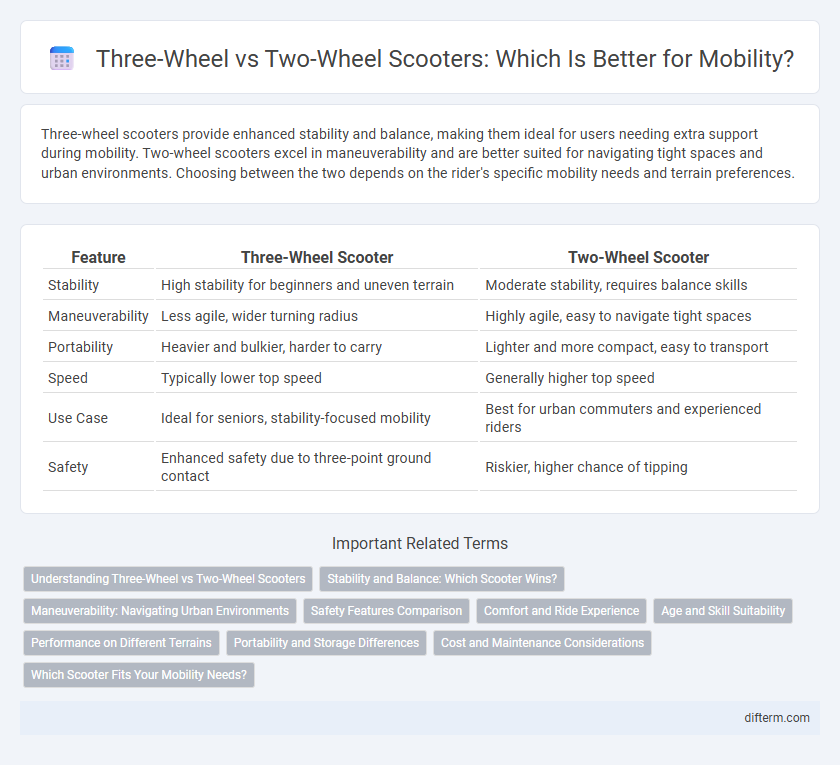Three-wheel scooters provide enhanced stability and balance, making them ideal for users needing extra support during mobility. Two-wheel scooters excel in maneuverability and are better suited for navigating tight spaces and urban environments. Choosing between the two depends on the rider's specific mobility needs and terrain preferences.
Table of Comparison
| Feature | Three-Wheel Scooter | Two-Wheel Scooter |
|---|---|---|
| Stability | High stability for beginners and uneven terrain | Moderate stability, requires balance skills |
| Maneuverability | Less agile, wider turning radius | Highly agile, easy to navigate tight spaces |
| Portability | Heavier and bulkier, harder to carry | Lighter and more compact, easy to transport |
| Speed | Typically lower top speed | Generally higher top speed |
| Use Case | Ideal for seniors, stability-focused mobility | Best for urban commuters and experienced riders |
| Safety | Enhanced safety due to three-point ground contact | Riskier, higher chance of tipping |
Understanding Three-Wheel vs Two-Wheel Scooters
Three-wheel scooters offer enhanced stability and balance, making them ideal for beginners and older riders, while two-wheel scooters provide greater maneuverability and speed preferred by experienced users. The weight distribution in three-wheel scooters reduces the risk of tipping, which improves safety during turns and uneven terrains. Choosing between three-wheel and two-wheel scooters depends on the rider's skill level, intended use, and comfort with handling dynamic movements.
Stability and Balance: Which Scooter Wins?
Three-wheel scooters provide enhanced stability and balance due to their wider base and additional wheel, making them ideal for beginners and riders seeking extra support. Two-wheel scooters offer greater agility and maneuverability but require better balance and coordination, often favored by experienced riders. When prioritizing safety and stability, three-wheel scooters generally outperform two-wheel models in maintaining balance during various riding conditions.
Maneuverability: Navigating Urban Environments
Three-wheel scooters offer enhanced stability and balance, making tight turns and sudden stops easier in crowded urban environments compared to two-wheel scooters. Their wider base provides increased control over uneven surfaces, reducing the risk of tipping during sharp maneuvers. Two-wheel scooters generally allow for quicker, more agile movements but require greater rider skill to navigate congested city streets safely.
Safety Features Comparison
Three-wheel scooters offer enhanced stability and balance due to their wider base and additional wheel, reducing the risk of tipping compared to two-wheel scooters. Many three-wheel models include advanced safety features such as anti-lock braking systems (ABS) and improved traction control, which are less common on two-wheel scooters. Two-wheel scooters, while more agile, often require greater rider skill to maintain balance, making three-wheel scooters a safer choice for beginners and those with mobility challenges.
Comfort and Ride Experience
Three-wheel scooters provide enhanced stability and balance, making them ideal for users seeking a more comfortable and secure ride, especially over uneven terrain. Two-wheel scooters offer greater maneuverability and a lighter frame, which can lead to a more agile and dynamic ride experience but may sacrifice some comfort on longer journeys. The choice between the two depends on the rider's priority for stability versus nimbleness in daily mobility.
Age and Skill Suitability
Three-wheel scooters offer enhanced stability, making them ideal for young children and beginners developing balance and coordination skills. Two-wheel scooters, preferred by older kids and experienced riders, support advanced maneuverability and higher speeds. Choosing the appropriate scooter depends on the rider's age, skill level, and intended use to ensure safety and enjoyment.
Performance on Different Terrains
Three-wheel scooters offer enhanced stability and balance, making them ideal for uneven or rough terrains, such as gravel or grass, where two-wheel scooters may struggle. Two-wheel scooters excel in agility and speed on smooth, paved surfaces but can be less effective on inclines or loose ground. Choosing between the two depends on the primary terrain, with three-wheel scooters providing superior control in diverse outdoor environments and two-wheel scooters favoring urban, flat conditions.
Portability and Storage Differences
Three-wheel scooters offer enhanced stability but tend to be bulkier and less portable compared to two-wheel scooters, which excel in compact design and foldability for easy storage. The weight and frame size of three-wheel models often require more storage space, making them less convenient for users with limited room or those needing quick transport options. Two-wheel scooters prioritize lightweight materials and streamlined construction, enabling effortless carrying and fitting into tight spaces such as car trunks or small closets.
Cost and Maintenance Considerations
Three-wheel scooters generally cost more upfront due to their enhanced stability features and added components, but they often require less frequent maintenance on balance-related parts compared to two-wheel scooters, which may incur higher costs from regular tire and alignment repairs. Battery life and motor upkeep are similar across both types, though two-wheel scooters' simpler design can sometimes result in lower replacement part expenses. When budgeting for long-term use, consider that three-wheel models may offer more durability, potentially reducing unexpected maintenance fees over time.
Which Scooter Fits Your Mobility Needs?
Three-wheel scooters offer enhanced stability and balance, ideal for individuals requiring extra support during mobility, while two-wheel scooters provide greater maneuverability and speed for users comfortable with balancing. The choice depends on factors such as terrain, average travel distance, and the user's physical condition. Evaluating these aspects ensures selecting a scooter that best fits individual mobility needs and lifestyle.
three-wheel scooter vs two-wheel scooter Infographic

 difterm.com
difterm.com